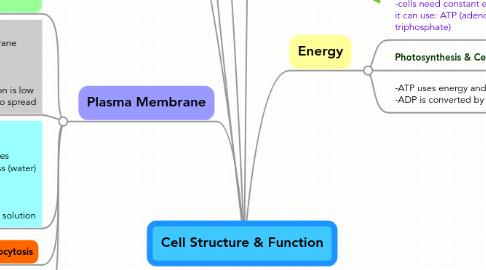
1. Endomembrane system
1.1. ER -membranous channels that process & modify proteins
1.2. Smooth ER -no ribosomes -various lipid synthesis
1.3. Rough ER -protein synthesis w/ ribosmes attached
1.4. ribosomes synthesize proteins -attached to ER are secreted for use outside of the cell -proteins formed @ cytoplasmic ribosomes are used inside the cell
1.5. Golgi Apparatus -stack of membranous saccules -processing, packaging & distributing of proteins & lipids
1.6. Lysosome -produced by golgi -membranous sacs/vesicles containing digestive enzymes -intracellular digestion: “suicide cells” destroys bad cells by taking it in and self-destructing
2. Cell Theory
2.1. 1) Cells are the basic living unit, structure determines function in organisms 2) All organisms are cellular, composed of one or more cells 3)All cells come from pre-existing cells
2.2. Solidified with the Microscope
2.2.1. Changed the way humans thought about living things -resolution: ability to distinguish between 2 objects as separate parts
2.2.2. -light microscopes can see living organisms -use light rays, longer wave lengths: 200 x 10-6 mm
2.2.3. -electron microscope have to use dried organisms -shorter wavelengths= more detail
2.2.4. millimeter 10-3m ex) frogs egg micrometer 10-6m ex) plant/animal cells nanometer 10-9 ex) macromolecules
2.3. Isolating Cells -cell fragmentation: separates cells or organelles into smaller parts -centrifuge is a process that spins cell @ high speeds, separating the dense and lighter parts
2.4. size of cells -small cell=more surface area/volume -large cell=less surface area/volume -nutrients & waste enters & leaves the cell @ it’s surface -the amount of the surface affects the ability to get material in & out of the cell -surface area of a large cell actually decreases proportionately, cell size stays small
3. Eucaryotic Cell
3.1. -True Nucleus surrounded by nuclear envelope w/ pores - contains sacs inside that can move between cytoplasm and nucleoplasm - chromatin (a complex of DNA and protein) -when cell divides DNA is found in separate structures called chromosomes -nucleolus (special region of chromatin) forms ribosomal RNA -Both plant and animal cells
3.2. Animal Cells -centrioles only in animal cells, involved in the process of nuclear division
3.3. Plant Cells -only have chloroplast -It builds up carbohydrates and mitochondria breaks it down -process of cellular respiration to build a supply of ATP(energy currency of cells) -uses molecules that mitochondira gives off -mainly CO2 and H20 as raw material for photosynthesis which uses energy from the sun
3.4. Mitochondria
3.4.1. -inner membrane (cristae), great surface area for proteins & production of ATP -matrix contains DNA, ribosomes & enzymes for breaking down carbohydrates
4. Procaryotic Cell
4.1. -has plasma membrane, cell wall, ribosomes and DNA -does not have nucleus does not have membrane-bounded organelles
5. Energy
5.1. -cells need constant energy, only form it can use: ATP (adenosine triphosphate)
5.2. Photosynthesis & Cellular Respiration
5.3. -ATP uses energy and becomes ADP -ADP is converted by mitochondria to form ATP
6. Plasma Membrane
6.1. The Fluid-Mosiac Model -structure refers to the fluidity of the phospholipid bilayers and pattern of proteins in the membrane -consist of lipid bilayer w/ consistency of oil -hydrophilic heads & hydrophobic tails -selectively permeable: allows only some molecules through -Proteins make up the mosiac part -receptors: shape allows molecules to bind -carrier: allows selectively molecules to pass only - cell-cell recognition
6.2. Diffusion - lipid-soluble compounds, gas, water can simply move across the membrane -no energy required from high to low concentrations -rate if diffusion depends on: -temperature: the higher the faster KMT -concentration gradient: molecules move to where their concentration is low -size and shape of molecules: heavier molecules are denser, harder to spread
6.3. Osmosis - water moving across membrane -tonicity: the amount of dissolved solute particles -isotonic solution: cell neither gains or lose mass (water) -hypotonic solution: cell gains mass (water) -lysis: cell overflows with water, may burst -hypertonic solution: cell loses mass (water) -crenation: cell shrivels up in a hypertonic solution
6.4. Exocytosis
6.4.1. -large substances can exit the cell -secretion: vesicles (often from golgi) fuse with plasma membrane
6.5. Endocytosis
6.5.1. -large substances can enter the cell -secretion: vesicles (often from golgi) fuse with plasma membrane
